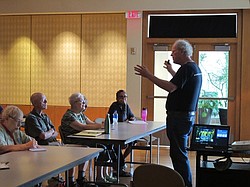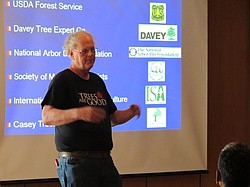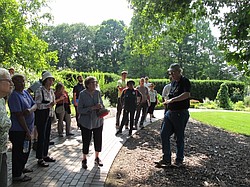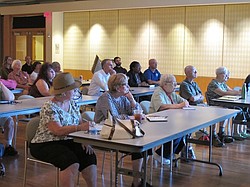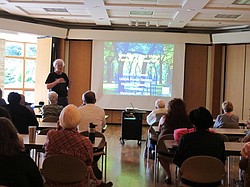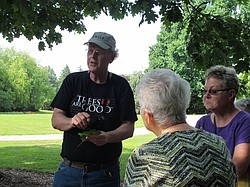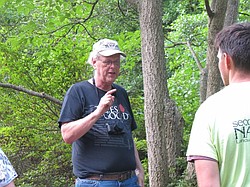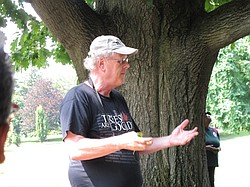Neighbors | Jessica Harker.Jim Chatfield lectured at Fellows Riverside Garden about urban trees on July 11.
Neighbors | Jessica Harker.Jim Chatfield lectured at the Fellows Riverside Garden July 11 about the importance of urban trees.
Neighbors | Jessica Harker.A large crowd gathered outside while Jim Chatfield discussed the local trees in Mill Creek Park on July 11.
Neighbors | Jessica Harker.A crowd gathered to listen to Jim Chatfield lecture about urban trees at Fellows Riverside Garden.
Neighbors | Jessica Harker.Jim Chatfield lectured at Fellows Riverside Garden about urban trees on July 11.
Neighbors | Jessica Harker.Jim Chatfield discussed the difference between tree leaves at the Mill Creek park during his urban trees lecture on July 11.
Neighbors | Jessica Harker.On July 11, Jim Chatfield lectured outside about the importance of urban trees at Mill Creek park.
Neighbors | Jessica Harker.Jim Chatfield discussed the importance of local trees while he stood outside next to a red oak at the Mill Creek Park.
By JESSICA HARKER
On July 11, Ohio State University Associate Professor Jim Chatfield visited Fellows Riverside Garden to give a lecture about the importance of urban trees.
Chatfield works in the department of Horticulture and Crop Sciences at OSU.
“The trees play a very important role in our environment and in our enjoyment of the environment and in our local economy. There is obviously a large green industry of landscapers and arborists and people who take care of trees, who plant trees, in nurseries and garden centers,” Chatfield said.
He said that other than the obvious economics surrounding tree related industries, what a lot of people don’t know is that one tree saves individual home owners and cities certain amounts of money each year.
“A 24-inch oak, might provide between $150 and $200 in environmental services annually to a community in terms of energy savings if placed in the right location, in terms of storm water re-mediation relative to what happens during a storm event and how that relates to storm water sewers, relative to carbon sequestration, air quality benefits, and that’s just the obvious stuff.” Chatfield said.
One way Chatfield said an individual or a community as a whole would be able to determine these benefits is by utilizing a free software called I-Tree.
I-Tree allows anyone who has basic information about a tree, including its type, diameter, location and other factors, to estimate its economic benefits.
The application actually breaks down the monetary value into charts, explaining how that specific tree, or number of trees, effects each aspect of the chart which saves the user money.
“We have some really wonderful tools. I tree is really looking at the economic services that trees provide,” Chatfield said, “So we have really good estimates now that a tree of a certain size in a certain location with a model, and looking at how that actually plays out.”
He said not only do trees provide a hard line monetary value to a neighborhood, but the aesthetic appeal of trees and other foliage can have a big impact on any location.
“More than anything it is a wide range of benefits, just to increase enjoyment and awareness of the benefits of trees,” Chatfield said.
He said that most people believe that the main benefits a tree has on any area is to increase air quality, but that simply isn’t true.
“We can’t fix, by planting a tree, the air quality of a big city, or even a town. It will help a little bit but the negative effects we have on the environment through industry are too much to battle in that way.” Chatfield said, “What we can do is increase housing prices, add aesthetic appeal, stop sewage overflow and other things no one ever thinks of.”
Chatfield showed examples of other groups of people, mostly college students, who used the I-Tree software to create signs that let the public know the economic benefits of any specific tree in the area.
“Your mission is to start a program like this to show how much economic benefit we get from trees in Youngstown,” Chatfield said.
After the first half of his presentation, Chatfield decided to take the group on a walk into the surrounding Mill Creek park woods, to discuss the trees and get to experience them first hand.
He encouraged questions, and talked on a range of topics including which trees would be best to plant locally, and what kind of invasive species harm certain types of trees.
“A lot of it is just appreciation and enjoyment of what we already have,” he said.
The lecture was sponsored by OSU Extension, Mill Creek Metro Parks and the Youngstown City Scape.
 43
43

